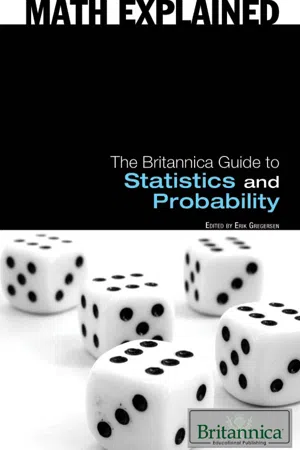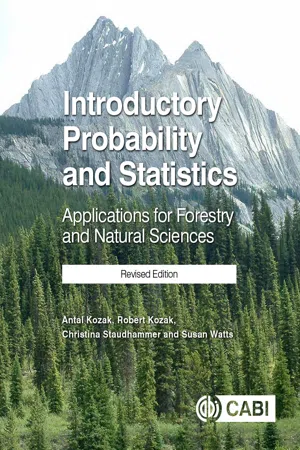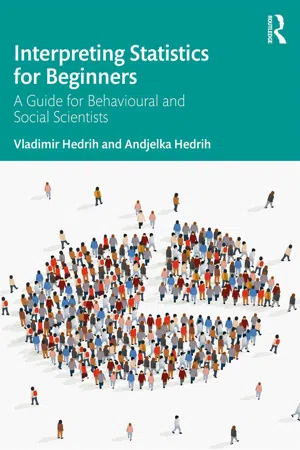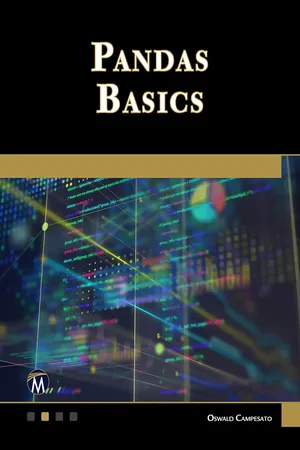Mathematics
Probability and Statistics
Probability and statistics are branches of mathematics that deal with the analysis of uncertainty and variability. Probability focuses on predicting the likelihood of future events based on data and assumptions, while statistics involves collecting, analyzing, and interpreting data to make informed decisions and predictions. These fields are widely used in various disciplines to quantify and understand uncertainty and randomness.
Written by Perlego with AI-assistance
Related key terms
10 Key excerpts on "Probability and Statistics"
- eBook - ePub
Teaching Mathematics in Primary Schools
Principles for effective practice
- Robyn Jorgensen(Author)
- 2020(Publication Date)
- Routledge(Publisher)
CHAPTER 14STATISTICS AND PROBABILITYWhat are Probability and Statistics?Probability and Statistics are encountered with regularity in everyday life. It is generally accepted that this is one of the key numeracies in the new millennium because of the data-saturated society in which we live, the rapid changes occurring in society and work, and the growing use of computer technology. Many educators and social commentators argue that the significant changes occurring in Western societies are akin to the changes that resulted from the move from agrarian communities to the organised workplaces of the Industrial Revolution. Contemporary theorists and educationalists argue that students need to enter this world able to make sense of the multifarious forms of information presented to them. For mathematics teachers, the task is one of preparing students for a society in which they need to be able to make informed decisions about whether or not a particular medical procedure or treatment is worth the risk, about their money and how to invest it, about which of many credit options to make purchases on, about risks associated with various types of purchases of cars or other items, and so on. To do this, they need to be able to evaluate the likelihood of events occurring (probability) and use information (data) to make the most appropriate decisions (Makar et al. 2011). Since much of the information they seek is now available online, internet-related activities should be included in teaching.Statistical literacy
A renewed focus on statistics and probability in the Australian curriculum underscores how an understanding of chance and data is the linchpin of effective survival in the world beyond school. It is therefore vital that key skills and attitudes be developed. The emphasis of this strand goes beyond exploring probability and constructing graphs. It is far broader, and directly targets the development of statistical literacy. The characteristics that define this literacy include being able to identify the types of data that need to be collected; undertaking and subsequently organising the data collected; representing the data in ways that make sense and result in high levels of readability; and being able to interpret and critique data. Everyday literacy and numeracy are combined in this strand—today, even reading the newspaper involves interpretation of considerable statistical numeracy. Being able to interpret and - Britannica Educational Publishing, Erik Gregersen(Authors)
- 2010(Publication Date)
- Britannica Educational Publishing(Publisher)
CHAPTER 1 HISTORY OF STATISTICS AND PROBABILITYS tatistics and probability are the branches of mathematics concerned with the laws governing random events, including the collection, analysis, interpretation, and display of numerical data. Probability has its origin in the study of gambling and insurance in the 17th century, and it is now an indispensable tool of both social and natural sciences. Statistics may be said to have its origin in census counts taken thousands of years ago. As a distinct scientific discipline, however, it was developed in the early 19th century as the study of populations, economies, and moral actions and later in that century as the mathematical tool for analyzing such numbers.EARLY PROBABILITY
It is astounding that for a subject that has altered how humanity views nature and society, probability had its beginnings in frivolous gambling. How much should you bet on the turn of a card? An entirely new branch of mathematics developed from such questions.GAMES OF CHANCEThe modern mathematics of chance is usually dated to a correspondence between the French mathematicians Pierre de Fermat and Blaise Pascal in 1654. Their inspiration came from a problem about games of chance, proposed by a remarkably philosophical gambler, the chevalier de Méré. De Méré inquired about the proper division of the stakes when a game of chance is interrupted. Suppose two players, A and B , are playing a three-point game, each having wagered 32 pistoles, and are interrupted after A has two points and B has one. How much should each receive?Blaise Pascal invented the syringe and created the hydraulic press, an instrument based upon the principle that became known as Pascal’s law . Boyer/Roger Viollet/Getty ImagesFermat and Pascal proposed somewhat different solutions, but they agreed about the numerical answer. Each undertook to define a set of equal or symmetrical cases, then to answer the problem by comparing the number for A with that for B . Fermat, however, gave his answer in terms of the chances, or probabilities. He reasoned that two more games would suffice in any case to determine a victory. There are four possible outcomes, each equally likely in a fair game of chance. A might win twice, AA ; or first A then B might win; or B then A ; or BB . Of these four sequences, only the last would result in a victory for B . Thus, the odds for A are 3:1, implying a distribution of 48 pistoles for A and 16 pistoles for B- eBook - ePub
Introductory Probability and Statistics
Applications for Forestry and Natural Sciences (Revised Edition)
- Robert Kozak, Antal Kozak, Christina Staudhammer, Susan Watts(Authors)
- 2019(Publication Date)
- CAB International(Publisher)
3 Probability The Foundation of Statistics We use statistical information every day to qualify statements and to help us make decisions. For example, we may hear statements like: • There is an 80% chance of rain today. • The odds are one in 13 million that you will win the lottery. Or we may be confronted with questions like: • What is the likelihood of receiving an A on the first exam in this course? • What is the chance that the Vancouver Canucks will win the next Stanley Cup? Statistical inference, the generalization from a sample to a population, involves drawing a conclusion about a population on the basis of available, but incomplete, information. Hence, statistical inference involves a certain amount of uncertainty, and statisticians should not base decisions on statistical inference unless the risk of uncertainty can be reduced to a tolerable minimum. Problems involving ‘uncertainty’, ‘chance’, ‘likelihood’, ‘odds’ and other such factors require an understanding and application of the theory of probability. Probability is the branch of mathematics that incorporates the most important set of concepts used in the field of statistics. The purpose of this chapter is to introduce the basic theories of probability that are required to appreciate and understand many of the concepts of statistical inference. 3.1 Sample Space and Events In statistics, we define an experiment as a process that produces some data. In Chapter 1, we described an experiment to study the effects of seeding date and seedbed preparation on germination. A wood scientist could be interested in studying the effect of temperature and applied pressure on the strength properties of plywood. Experi ments such as tossing a coin, rolling a dice, or drawing a card from an ordinary (52 cards) deck of cards will also produce some data - Daniel J. Denis(Author)
- 2015(Publication Date)
- Wiley(Publisher)
2 MATHEMATICS AND PROBABILITY THEORYHow can it be that mathematics, being after all a product of human thought which is independent of experience, is so admirably appropriate to the objects of reality? … As far as the laws of mathematics refer to reality, they are not certain, and as far as they are certain, they do not refer to reality.(Einstein, 1922)In this chapter, we review some of the essential elements of mathematics and probability theory that the reader may have learned in prior courses, or at minimum, has had some exposure through self‐study. We reserve Chapter 3 for a review of the elements of essential statistics that is generally required for an understanding of the rest of the book. Our distinction between mathematics and probability versus statistics is not a sharp one. In this chapter, we use mathematics as a vehicle to understanding applied statistics rather than see it as a field in its own right, which, of course it is, with a variety of branches and subdisciplines.Our brief mathematics review draws material sparingly from introductory courses such as precalculus, calculus, linear and matrix algebra, and probability. Such topics constitute the very bedrock of mathematics used in applied statistics. Elements such as functions, continuity, limits, differential and integral calculus and others are (very) briefly reviewed. We also present some of these fundamentals using R where appropriate. For an excellent review of essential mathematics for the social sciences, refer to Gill (2006). Barnett, Ziegler, and Byleen (2011) also provide a very readable overview of mathematics covering a wide range of topics. Fox (2008a) is also a useful monograph. Refer to Gemignani (1998) for how calculus is used in statistics.We do not pretend to cover any of these topics in any respectable depth whatsoever, having only the space to provide brief and relatively informal overviews of these essential concepts. If you lack familiarity with such fundamentals, a bit of time taken to study and appreciate these elements can be of great help in understanding material covered in this book and beyond. This is not to say that without this knowledge you cannot learn and apply principles presented in the book, but the deeper your knowledge of these concepts, the more confident you will likely be in applying your skills to data analysis because you will be better familiar with the “rules of the game.”- Amit Kumar Gorai, Snehamoy Chatterjee(Authors)
- 2022(Publication Date)
- CRC Press(Publisher)
2 Basics of Probability and Statistics DOI: 10.1201/9781003200703-2 2.1 Definition of probability Probability is defined as the chances of occurrence of any event in an experiment. The sum of all the possible outcomes is called the sample space, and a subset of sample space is known as an event. If there are S exhaustive (i.e., at least one of the events must occur), mutually exclusive (i.e., only one event occurs at a time), and equally likely outcomes of a random experiment (i.e., equal chances of occurrence of each event) and r of them are favourable to the occurrence of an event A, the probability of the occurrence of the event A is given by P (A) = r S (2.1) It is sometimes expressed as ‘odds in favour of A ’ or the ‘odds against A ’. The ‘odds in favour of A ’ is defined as the ratio of occurrence of event A to the non-occurrence of event A. On the other hand, ‘odds against A ’ is defined as the ratio of non-occurrence of event A to the occurrence of. event A Odds in favour of A = P r o b a b i l i t y o f o c c u r r e n c e o f e v e n t A P r o b a b i l i t y o f non-occurrence o f e v e n t A = r / S (S − r) / S = r S − r Again, Odds against A[--=PLGO-SEPARATOR. =--]= P r o b a b i l i t y o f non-occurrence o f e v e n t A P r o b a b i l i t y o f o c c u r r e n c e o f e v e n t A = (S − r) / S r / S = S − r r The total probability of the occurrence of any event ranges from 0 to. 1. i.e., 0 ≤ P (A) ≤ 1 P (A) = 0 indicates event A is impossible, and P (A) = 1 indicates the event is certain. In the above discussion, the discrete sample space was considered. But, the probability can also be determined for a continuous sample space. For a continuous sample space, the probability of occurrence is measured as a probability density function. The probability density function of any continuous random variable gives the relative likelihood of any outcome in a specific range- J. P. Verma(Author)
- 2014(Publication Date)
- Wiley(Publisher)
Chapter 4 Probability and its Application4.1 Introduction
Probability is a chance of an event happening in the future. In our day-to-day decisions, we use the concept of probability. While driving the car we assume that the probability of accidents is very low, or we would not drive the car. During a cricket match, we often assume a low probability of being hit by another player. During a tennis match, a player needs to take a call on whether the ball will cross the sideline, and if he feels that it is highly probable that the ball would fall outside the line, he leaves it. If the player does not make that assumption, he would probably not leave the ball for fear of losing a point. In assuming many probabilities, we constantly live in fear of the horrible things that might happen to us. Decisions based on Probability and Statistics provide us with the ability to cope with uncertainty. It has tremendous power in improving the accuracy in our decision-making capacity and in testing new ideas. Within Probability and Statistics, there are many applications with profound or unexpected results. Let us see how the concept of probability came into existence.Probability theory grew out of attempts to understand gambling. Gambling was popular before the theory of probability was formed. Gamblers used to identify simple laws of probability by witnessing the events firsthand. The notion of probability has been around for thousands of years, but probability theory as a branch of mathematics did not come into existence until the mid-seventeenth century. Several works on probability were noticed during the fifteenth century. Computing probabilities became more noticeable during this period even though mathematicians in Italy and France remained unfamiliar with these calculation methods.During the mid-seventeenth century, a simple question posed to Blaise Pascal by his friend led to the birth of probability theory as we know it today. Chevalier de Méré used to gamble frequently to increase his wealth. He bet on the throw of a dice that at least one 6 would appear during a total of four throws. From his past experience, he knew that he was more successful than not with this game of chance. He was tired of this approach and wanted to do something different. He bet that he would get a total of 12 in throwing two dice 24 times.- eBook - ePub
Interpreting Statistics for Beginners
A Guide for Behavioural and Social Scientists
- Vladimir Hedrih, Andjelka Hedrih(Authors)
- 2022(Publication Date)
- Routledge(Publisher)
Law of large numbers that states that the ratios of outcomes of an observed random event will become closer to their true probabilities as the number of observed events (referred to as trials) increases. When the number of observations is small it is much more likely that our outcomes deviate more from their true probabilities. For example, when throwing dice, it is much easier to obtain 6 in 2 throws in a row than in 10 throws in a row. If we threw dice a million times, it would be practically impossible that we get a 6 every time in those million times. This of course, assuming that the dice has the same probability of landing on each of its sides (each of which is marked with a different number from 1 to 6).Now, as we discussed in previous chapters, assessing probability like this implies two “leaps of faith”:- that the event we are observing is truly random, while it is either not or it is not certain that it is random. However, we can refer to past observations to note whether it has behaved in the past in a way that we would expect a random event to behave. If this is the case, we can declare that it is sufficiently similar in behavior to a random event to be treated as such.
- that the observed event or class of events will behave in the future in the same way it has behaved in the past, meaning that the likelihoods of occurrence of particular outcomes, i.e. their probabilities, will remain the same. Now, people who apply statistics in practice have a well-known saying that past trends and success of past statistical predictions are often poor indicators of future trends and the success of future predictions. Belief that phenomena will behave in the future in the same way they behaved in the past, without knowing enough about their nature to support this notion is at least a risky proposition. However, when nothing better is available, this approach becomes the best available option (see statistical explanations in the previous chapter).
2.3 Entity
Statistical observations and statistical calculations are usually done on certain properties of certain objects. These objects can be of any possible nature and they widely differ in various scientific areas in which statistics is applied. In social sciences, these objects may be persons, or groups of people or organizations. In biology they may be organisms, plants, animals. Or they may be paintings, or pieces of equipment, or subatomic particles or parts of objects etc. And they are usually studied in sets, as that is how statistics works. - eBook - ePub
- Ivor Grattan-Guiness, Ivor Grattan-Guiness(Authors)
- 2004(Publication Date)
- Routledge(Publisher)
Part 10 Probability and Statistics, and the Social SciencesPassage contains an image 10.0 Introduction
10.1 Combinatorial probablity Eberhard Knobloch10.2 The early development of mathematical probability Glenn Shafer10.3 Actuarial mathematics C. G. Lewin10.4 Estimating and testing the standard linear statistical model R. W. Farebrother10.5 Theory of errors O. B. Sheynin10.6 Russian Probability and Statistics before Kolmogorov E. Seneta10.7 The English biometric tradition Theodore M. Porter10.8 Probability, statistics and the social sciences Theodore M. Porter10.9 Psychology and probability: Two sides of the same coin Gerd Gigerenzer10.10 Probability and Statistics in genetics A. W. F. Edwards10.11 Probability and Statistics in agronomy Zeno G. Swijtink10.12 Probabilistic and statistical methods in medicine J. Rosser Matthews10.13 Probability and Statistics in mechanics Zeno G. Swijtink10.14 Statistical control of manufacture Denis Bayart and Pierre Crépel10.15 The social organization of Probability and Statistics Theodore M. Porter10.16 Foundations of probability A. P. Dawid10.17 Philosophies of probability Donald A. Gillies10.18 Mathematical economics Giorgio IsraelThe location of this Part well on in the encyclopedia reflects the historical fact that Probability and Statistics arrived relatively late as major branches of mathematics. While probability theory began to develop in the seventeenth century (with intuitive probabilistic thinking evident much earlier in some contexts), mathematical statistics did not really emerge until the late eighteenth and the nineteenth century, and many main theories and traditions belong to the twentieth century. Further, the nature and timing of their introductions varied with different disciplines (a curious phenomenon in itself, and not yet fully explained by historians); major progress in many sciences commenced only during the late nineteenth or even the twentieth century. This state of affairs is reflected, for example, in the rather small place granted to Probability and Statistics in the Encyklopädie der mathematischen Wissenschaften - eBook - ePub
- Oswald Campesato(Author)
- 2022(Publication Date)
- Mercury Learning and Information(Publisher)
3INTRODUCTION TO PROBABILITY AND STATISTICST his chapter introduces you to concepts in probability as well as an assortment of statistical terms and algorithms.The first section of this chapter starts with a discussion of probability, how to calculate the expected value of a set of numbers (with associated probabilities), and the concept of a random variable (discrete and continuous), as well as a short list of some well-known probability distributions.The second section of this chapter introduces basic statistical concepts, such as mean, median, mode, variance, and standard deviation, along with simple examples that illustrate how to calculate these terms. You will also learn about the terms RSS, TSS, R^2, and F1 score.The third section of this chapter introduces the Gini impurity, entropy, perplexity, cross entropy, and KL Divergence. You will also learn about skewness and kurtosis. The fourth section explains covariance and correlation matrices and how to calculate eigenvalues and eigenvectors. The fifth section explains PCA (Principal Component Analysis), which is a well-known dimensionality reduction technique. The final section introduces you to Bayes’ Theorem.WHAT IS A PROBABILITY?
If you have ever performed a science experiment in one of your classes, you might remember that measurements have some uncertainty. In general, we assume that there is a correct value, and we endeavor to find the best estimate of that value. - eBook - ePub
Structural Health Monitoring
A Machine Learning Perspective
- Charles R. Farrar, Keith Worden(Authors)
- 2012(Publication Date)
- Wiley(Publisher)
probability of the signal taking on a certain value.This concept is vital for an understanding of SHM because many (if not all) of the signals measured in an SHM context will be unpredictable or random for various reasons. One example of importance relates to measurements taken over different environmental conditions. If the result of a measurement depends on the ambient temperature, which is not measured but fluctuates between measurements, the sequence of measurements will display an unpredictable component that can only be accommodated in a probabilistic setting. Instrumentation noise will introduce an uncertain component to measurements even if the environment is constant; however, this is usually small if the instrumentation is selected carefully.Before one can discuss these issues in detail, a review of the basic concepts of Probability and Statistics should be conducted. The theory of statistics is distinct from probability theory in that it is not fundamentally concerned with the likelihood or not of events; it is concerned with the extraction of summary information from bodies of data. As such, it is just as important for SHM purposes as probability theory. The very strong link between the two ideas is that the summary information from statistics can often be used to estimate probabilities. The term statistic as applied to a single number will be understood here to mean a summary figure that results from statistical analysis – the arithmetic mean of an array of numbers is a common example.6.2 Probability: Basic DefinitionsDefining the concept of probability is not straightforward. It is not trivial to explain the basis of the concept without using words that one later has to give a technical meaning to. In order to make some progress, let us argue that probability is ultimately concerned with degrees of belief . Consider a question of some importance in the context of SHM: what is the probability that bridge A will fall down tomorrow? Experts in the structural dynamics of bridges will formulate their answer on the basis of any evidence before them; therefore, for example, if a dynamic test carried out that morning showed that the dynamic properties of the bridge are the same as on the day the bridge opened, the expert may consider that this is strong evidence that no deterioration in the bridge structure has occurred and the bridge is very unlikely to fall down tomorrow. If small changes in the dynamic properties have occurred since commissioning, the expert may look into their body of experience or carry out some analysis and may be able to quantify their degree of belief in the safety of the structure; they may offer a judgement that they are ‘99% certain that the bridge is safe’. This process, although informed by evidence, is clearly subjective; however, it is perfectly possible to develop a probability theory on the basis of such concepts. Suppose now that the evidence in front of the expert takes the following form. The bridge in question is one of many that were built to the same design and the expert has the results of all structural tests on all these bridges available. On consulting the data, the expert finds that, of all the bridges that showed the same test results shown by bridge A on that day, 50% of them fell down the following day. On this evidence, the degree of belief in the safety of the bridge is likely to be equal to the degree of belief in disaster; with such a conclusion, the expert will very likely order the closure of the bridge. In this particular case, the evidence for a particular event is in the form of frequencies of occurrence and it can be argued that this is a more objective basis for the formulation of a prediction. Building a probability theory on the basis of such evidence is called the frequentist approach
Index pages curate the most relevant extracts from our library of academic textbooks. They’ve been created using an in-house natural language model (NLM), each adding context and meaning to key research topics.









